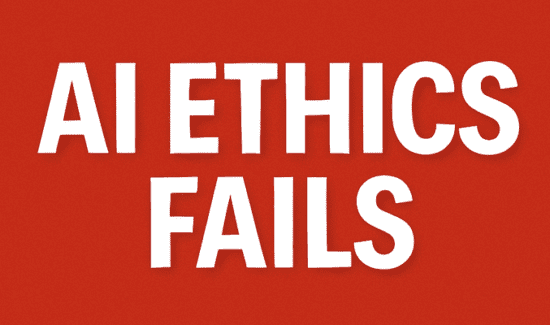An Introduction to AI Policy: Ethical AI Governance

Solutions Review Executive Editor Tim King offers an introduction to AI policy through the lens of ethical AI governance.
Ethical AI governance is not a safeguard for the future—it’s the operating system of the present. As AI technologies accelerate past traditional management structures, the need to install intentional, enforceable, and anticipatory governance has become existential. AI doesn’t merely speed up decision-making; it alters the logic of how decisions are made. If firms deploy these systems without governance that is both ethically grounded and organizationally actionable, they’re not managing risk—they’re externalizing it onto their workers, customers, and society at large. Ethical AI governance must therefore become the foundational layer of enterprise AI adoption, governing not just models, but motives.
At its core, ethical AI governance is about power accountability. It asks who gets to design, deploy, and benefit from AI—and who bears the cost when things go wrong. It requires firms to move beyond empty ethics statements and install real mechanisms for oversight, redress, escalation, and institutional memory. This begins with clear ownership structures. AI systems can’t be treated as orphan technologies. Every system—whether a productivity enhancer or a decision-automation engine—must have a named owner responsible for its performance, bias mitigation, data integrity, and downstream impacts. That owner must be empowered with cross-functional authority and report to a governance body that is independent enough to challenge the business case when ethical red flags appear.
Important: AI Won’t Replace You, But Lack of Soft Skills Might – Get Report
An Introduction to AI Policy: Ethical AI Governance
Most existing corporate governance structures are ill-equipped to handle AI because they’re reactive, analog, and slow. Ethical AI governance must be agile, digital-native, and designed to anticipate both technical drift (e.g., model degradation, bias amplification, hallucinations) and strategic misuse (e.g., deploying surveillance tools as productivity trackers, or offloading layoffs to algorithmic decision engines). This means installing algorithmic audit trails, impact assessments, and pre-deployment ethical review boards as standard procedure, not crisis response. It means including ethics checkpoints at every stage of the AI lifecycle—from data collection to model design to deployment to retraining. And it means embedding governance into DevOps pipelines, not tacking it on with a compliance checklist at the end.
Crucially, ethical governance isn’t just about harm avoidance—it’s about value alignment. It ensures AI systems align with the firm’s mission, stakeholder expectations, and human rights principles. That includes setting red lines for where AI should never be used—such as for scoring workers’ worth, replacing empathetic human roles (e.g., in counseling or elder care) without consent, or manipulating customer behavior beyond the bounds of informed choice. Governance must also demand explainability thresholds—if a decision cannot be reasonably explained to a human, it should not be automated. Period.
This raises a contrarian but vital point: not all AI should be deployed. Ethical AI governance must include kill switches—procedures for halting or canceling deployments that pass technical benchmarks but fail ethical ones. Just because a model works does not mean it should be unleashed. Companies need courage to say no to AI applications that might be legal but not just, efficient but not humane. This kind of governance requires moral clarity and organizational spine—not just regulatory compliance.
The ethical governance imperative also stretches beyond the enterprise to its ecosystem. Vendors and partners must be held to the same governance standards. If your SaaS provider deploys opaque AI models that interact with your workforce or customers, your governance framework must demand transparency, auditability, and contractual recourse. Similarly, employee voices must be built into governance design. Workers know when systems are misfiring long before dashboards do. Ethical AI governance that lacks worker input is not governance—it’s theater.
Practically speaking, firms should begin by establishing Ethical AI Councils with diverse representation: legal, technical, HR, operations, frontline workers, and external advisors. These bodies must have teeth—budget, veto power, and public reporting requirements. Firms should adopt tools like AI impact assessments (akin to GDPR’s data protection impact assessments), scenario simulations, and bias stress-testing environments. Governance metrics must be public, actionable, and tied to incentives, including executive compensation. If no one is paid or penalized based on AI’s ethical performance, governance is a façade.
And let’s be clear: ethical governance is not a drag on innovation—it’s a scaffolding for sustainable scale. Companies that treat governance as a barrier will move fast and break things. Companies that treat governance as strategy will move fast and build trust. In a future defined by intelligent systems, trust becomes the currency of competition. And trust, unlike compliance, cannot be retrofitted.
The case is straightforward: without ethical AI governance, you don’t have AI management—you have AI gambling. And in that game, it’s not just the company’s bottom line at stake—it’s the future of human-centered enterprise itself.
The Bottom Line
Firms should explain ethical AI governance first in their AI policy because governance is the architecture upon which every other principle—transparency, fairness, human-centeredness, safety—is either upheld or undermined. Governance isn’t one pillar of responsible AI—it is the foundation that determines whether the system will evolve in alignment with human values or drift into ethical failure, regulatory breach, or public backlash. Opening with a clear, candid explanation of your governance philosophy signals maturity, accountability, and intentionality. It tells employees, partners, customers, and regulators that you’re not just chasing AI adoption for speed or savings—you’re prepared to own the consequences of its use.
Being transparent about governance is in a firm’s best interest because it establishes trust, legitimacy, and strategic clarity—all of which are essential for AI systems that touch people’s jobs, rights, or lives. Internally, it creates alignment across functions: legal, data science, product, HR, and executive leadership need a common language and framework to navigate trade-offs, escalate risks, and know who’s responsible when something goes wrong. Without this clarity, AI projects either stall in ambiguity or move too fast without guardrails—both of which lead to failure.
Externally, transparency builds trust with users and regulators by showing that governance isn’t a black box or a last-minute patch, but a living system with accountability, review, and redress baked in. As regulations like the EU AI Act, ISO/IEC 42001, and the U.S. AI Bill of Rights gain traction, being upfront about governance isn’t just ethical—it’s preemptive compliance. It reduces the risk of litigation, reputational damage, and costly remediation. It also gives customers and investors confidence that your AI strategy is future-proof and principle-driven, not opportunistic.
To deliver this message effectively, firms should:
-
Lead with intent, not abstraction: Don’t open your policy with jargon about “trustworthy AI.” Instead, declare in plain language what ethical AI governance means in your firm—why you care, who is responsible, and how you will govern trade-offs, escalation, and system oversight over time.
-
Make governance tangible: Describe the actual structures in place—AI ethics councils, model review boards, impact assessments, risk thresholds, override procedures, red-teaming simulations, etc. Show that governance isn’t aspirational; it’s operational.
-
Tie it to your values and business model: Link your governance stance to your mission, your customer promise, and your workforce vision. Say clearly: “We will not deploy AI that compromises human dignity, violates privacy, or removes accountability—no matter how efficient it is.”
-
Invite scrutiny: Signal that your governance system is designed to learn and evolve. Invite feedback from employees, users, and external experts. Publish an annual AI governance report or post-mortems of major decisions. Transparency becomes credible when it’s paired with humility and iteration.
Ethical AI governance should be the first thing your policy addresses not just because it’s good ethics—but because it’s smart leadership. It’s the blueprint that makes everything else—transparency, human-centric design, reskilling, monitoring—possible in the real world. If you can’t govern your AI, you don’t control your AI. And if you can’t explain how you govern it, no one should trust you to deploy it.
Note: These insights were informed through web research and generative AI tools. Solutions Review editors use a multi-prompt approach and model overlay to optimize content for relevance and utility.



